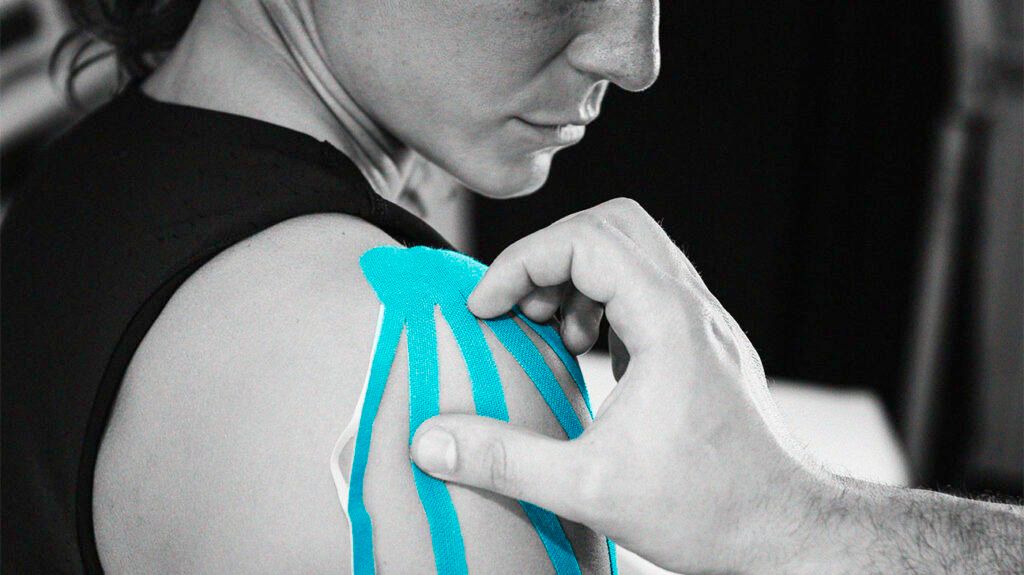Applying kinesiology tape (KT) to the front and back of the shoulder may help improve shoulder pain and help heal shoulder injuries.
KT consists of flexible material that can move with a person’s body. Applying the tape may help alleviate irritation, pain, and swelling without reducing the range of motion.
This article examines whether KT can help shoulder pain and how to use it. It also discusses when a person needs to contact a doctor about shoulder pain and other treatments.

A physiotherapist may recommend using KT to help relieve shoulder pain. The tape provides extra support to muscles and joints and may
A
They did not find sufficient evidence to support the use of KT to treat shoulder pain. However, they found some evidence that it may benefit some shoulder pain syndromes as a complementary treatment.
More research is necessary to determine whether KT can successfully relieve pain or whether it has significant benefits.
A large-scale 2021 review did not find evidence that KT could affect pain or increase the range of motion in the shoulder.
A person can apply the tape to the shoulder in different ways to target different problems and areas. Although more research is necessary, KT might help relieve shoulder pain in several ways. These include:
- limiting muscle spasms and improving stability
- increasing circulation and reducing swelling
improving joint alignment- providing support and stimulation
Before applying KT to the shoulder, a
- clean the skin on the arm and shoulder
- remove dense hair from the area
- round the edges of the tape to prevent lifting
- avoid applying tape to damaged or irritated skin
To treat a shoulder injury, a person can begin taping at the front of the shoulder. They can apply the starting and ending points of the tape, around
They can apply the tape by:
- cutting a piece of kinesiology tape measuring from the top of the front of the shoulder to the side of the arm
- reaching the affected arm behind the body to extend the shoulder
- removing some tape backing and applying some of the tape to the upper area of the front of the shoulder
- removing the remaining backing while gently pulling at the tape and pressing it down onto the skin until it reaches the mid-upper arm
- gently rubbing the tape down
A person can then apply KT to the back of the shoulder by:
- measuring and cutting another similar length of tape
- extending the affected arm across the front of the body to stretch the back of the shoulder
- peeling off a small area of backing and beginning to gently stretch the tape while pushing it onto the skin, starting from the top of the back of the shoulder
- removing the rest of the backing and pressing the tape down toward the side of the arm
- ensuring the back strip of the tape meets and slightly overlaps the front strip
- gently rubbing the tape down
To improve the range of motion and strength in the shoulder, a person may use KT in different formations. In one 2021 study, researchers applied four strips of tape to the shoulder by:
- applying the first strip from around the mid-upper arm toward the inner top of the shoulder blade
- applying the second, third, and fourth strips of tape from the front of the shoulder around the back of the arm to the shoulder blade in an overlapping fan position
The researchers did not use tensile force or stretch the tape during the application.
A person can discuss using KT with a physiotherapist, who can advise them on the best tape configuration for their needs. Additionally, individuals need to avoid wearing KT for longer than
There are various potential causes of shoulder pain. If pain is due to a serious injury, such as a severe fall or accident, a person needs to contact a doctor.
The pain may be due to a dislocation, strain, or fracture, which may require medical attention.
Individuals also need to contact a doctor if they cannot identify the cause of the pain. Shoulder pain may indicate a serious underlying issue, such as a heart attack.
Shoulder pain may be a medical emergency if it occurs with other symptoms, such as:
- sudden or severe pain
- a change in the shape of the shoulder
- rapid or irregular heartbeat
- pain in the chest
- swelling and pain in the legs
- one-sided body paralysis
- excessive sweating
- loss of consciousness
- fever
Treatments for shoulder pain may differ depending on their cause. They may include:
- Rest: Resting the shoulder may help relieve pain and discomfort from overuse or uncomfortable sleeping.
- Stretching and exercise: Exercise therapy and stretching may help reduce pain and improve shoulder mobility.
- Pain-relieving medication: Medication, such as nonsteroidal anti-inflammatory drugs (NSAIDs), corticosteroids, and muscle relaxers, can help
reduce pain in the shoulder. - Surgery: Individuals who have severe shoulder injuries or damage may require surgery. Doctors may be able to repair shoulder damage, such as rotator cuff tears, with surgical techniques. Surgery may be open, or arthroscopic, in which doctors insert a small camera into the shoulder joint to guide them.
More clinical evidence is necessary for researchers to determine whether kinesiology tape can help treat shoulder pain.
The tape may provide muscle and joint support and improve range of motion. It might also help reduce pain and inflammation.
A physiotherapist may be able to advise a person on the best application and configuration of KT to help relieve pain for specific shoulder issues.
If a person has severe shoulder pain or cannot explain the cause of the pain, they need to contact a doctor. Shoulder pain may indicate a serious medical condition, such as a heart attack. Dislocations, fractures, and other injuries may also require medical attention.
